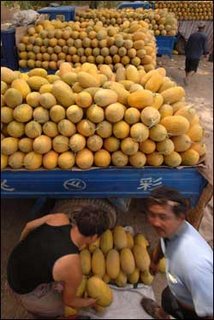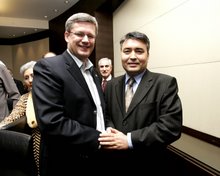Wednesday, August 30, 2006
China's push into western hinterlands has left many on the land feeling marginalized, writes Don Lee

Not too long ago, Kashgar was a sleepy town with mud houses, largely unchanged since Marco Polo trekked through in the 13th century.
But now, this frontier town, like other outposts in China's far west, is booming with oil, cotton, coal and trade. Trains, new highways and an international airport are bringing thousands of people from neighboring Pakistan who want to take in the tourist sites and buy inexpensive Chinese goods.
A few months ago, oil from Kazakhstan arrived by way of a new 965-kilometer pipeline financed by energy- hungry China. Trade with neighbors Kyrgyzstan and Tajikistan is breaking records.
China's soaring economy is often pictured in gleaming skyscrapers in coastal cities. But like America's Westward Ho of the 1800s, Beijing's Go West campaign of the past decade is transforming vast swaths of Central Asia by opening up China's western hinterlands, populated by millions of minority peoples. Hundreds of thousands of ethnic Chinese have flocked there, hoping to cash in with new construction jobs and business ventures.
Beijing, analysts say, is pushing west with two clear motives: to spread economic development and to keep in check Tibetans and, in Xinjiang region, the Uygurs, Muslims of Turkic descent. About nine million Uygurs live in Xinjiang, and over the years, separatist groups have clashed violently with Chinese forces, demanding independence and religious freedom.
For now, Beijing seems to have strengthened its economic and political grip in the region. While China has been a caldron of unrest, with 87,000 sometimes-violent protests nationwide last year, there has been no large-scale rioting in Xinjiang in two years, according to experts who track such activity.
Human-rights groups have accused the Chinese of taking advantage of America's war on terrorism, following the attacks on September 11, 2001, to increase repression of Uygurs. Beijing has repeatedly denied the claim, even as it has cracked down on Uygur activists and successfully lobbied the United States to label as terrorists a group of militant Uygurs in Xinjiang.
Although Beijing has used guns and force in the past to restrain Uygurs, in its arsenal of late have been people such as Wong Sonok, a merchant trader from Shenzhen in southeast China.
Marco Polo is said to have found Kashgar an oasis when he arrived there in 1275 on his journey through the Silk Road. When Wong arrived in 1998, there were more donkey carts than taxis in the city's mostly dirt roads. Kashgar and other areas of Xinjiang were still smoldering from rioting, bus bombings and assassinations in which scores of people were killed and injured.
The streets have since quieted. Today, the 50-year-old Wong sits behind a stately desk, overseeing the construction of an entrepot and international trading center similar to China's giant wholesale market in Yiwu in eastern Zhejiang province, where more than 3,000 foreign traders flock daily.
Some of those traders in Yiwu travel from Pakistan, Tajikistan and Kazakhstan. Wong's US$50 million (HK$390 million) International Trade City in Kashgar will shorten their trip. "We're creating a bridge to Central Asia," he says.
Beijing has provided US$15 billion for roads, dams and power transmission lines. State-owned energy companies have kicked in billions more, helping to pay for the pipeline from Kazakhstan's Caspian coast.
Xinjiang may be the linchpin of Beijing's push westward. The region is the size of Alaska, occupying one-sixth of China's land mass. Its climate and terrain is as varied as California's, with deserts and towering mountain ranges. Xinjiang is rich in coal and cotton, fruits and wine.

Although government figures on migration are not available, at least 180,000 Chinese from one distant province alone, Zhejiang, are estimated to have settled and started businesses in Xinjiang, many in the past decade.
The Han Chinese account for more than 90 percent of China's population and about 40 percent of Xinjiang's almost 20 million residents, according to the latest figures from Beijing. Apart from Arabic signs in Uygur enclaves, Urumqi, the region's capital, resembles most Chinese cities, with an abundance of pale apartment buildings, a People's Square in the center of town and KFCs sprinkled throughout.
Residents say Beijing's ongoing campaign has chilled Uygurs' hopes for an independent state. Many Uygurs declined to be interviewed, fearful of reprisals from police. Others said it was better to toe the line and secure economic gains, rather than spend time on political activities that would be quickly quashed.
The Uygurs in Xinjiang are in a "silent, pragmatic period," said Joanne Smith, a Uygur expert at Britain's Newcastle University.
In Kashgar, narrow alleys that meander through earthen houses are redolent of lamb and naan bread, sold by bearded skull-capped old men. Young craftsmen with their fathers sit in stalls fashioning bronze pots and Turkish long-neck lutes.
Inside a small storefront up a narrow alley, Abilkem, a lanky 22-year-old with a thin mustache, was behind a counter, facing a bank of nine red telephones, three of them for international calling. Ablikem, who like many Uygurs goes by one name, said business has been bustling with tourists and foreign visitors.
Some Uygur merchants are prospering from a rise in Chinese tourists and expanding trade with Central Asia.
But many Uygurs, especially those older, cannot communicate in Putonghua; they speak a Turkish language and read Arabic. That makes it tough to get jobs at Chinese companies.
Officially, the registered unemployment in Xinjiang, like many provinces of China, has been a steady 4 percent for years. But the streets tell a different picture.
In Kashgar's People's Park, Uygurs young and old sit forlornly on benches under trees in the middle of a hot afternoon. Chinese merchants nearby sell drinks and snacks. A lone Uygur peddles plum juice for 5 US cents a bowl.
Across the street, a 26-meter-high stone statue of Mao, said to be the tallest in all of China, reminds everyone who is in charge. LOS ANGELES TIMES
article source






No comments:
Post a Comment